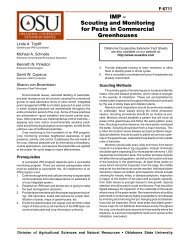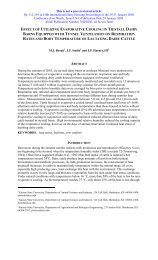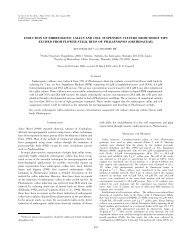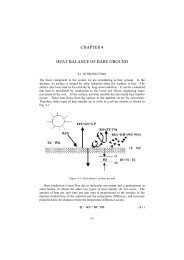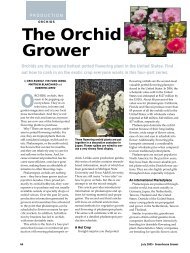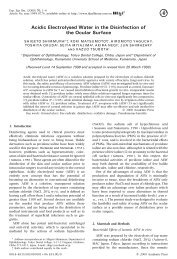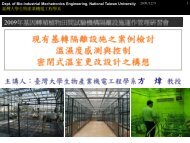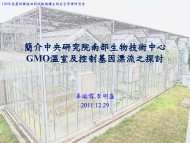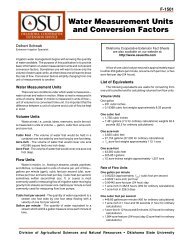Moisture Content Measurement of Bark and Sphagnum Moss Using ...
Moisture Content Measurement of Bark and Sphagnum Moss Using ...
Moisture Content Measurement of Bark and Sphagnum Moss Using ...
Create successful ePaper yourself
Turn your PDF publications into a flip-book with our unique Google optimized e-Paper software.
<strong>Moisture</strong> <strong>Content</strong> <strong>Measurement</strong> <strong>of</strong> <strong>Bark</strong> <strong>and</strong> <strong>Sphagnum</strong><strong>Moss</strong><strong>Using</strong> ECH2O Sensor for the Production<strong>of</strong> PhalaenopsisWei Fang <strong>and</strong> Walter RayDept. Of Bio_Industrial Mechatronics Engineering, National Taiwan UniversityAbstractTwo types <strong>of</strong> moisture ratio sensors (ECH 2 O-5, ECH 2 O-10, Decagon Device, Inc., USA)measuring dielectric constant <strong>of</strong> materials were used in this study. The converting equations providedfrom manufacturer are for soil only. Totally, 3 sizes <strong>of</strong> barks (Orchiata, Besgrow, NZ) <strong>and</strong> 3 sources(New Zeal<strong>and</strong>, Chile <strong>and</strong> China) <strong>of</strong> sphagnum moss were investigated. Besides equations derived,several conclusions are as follows: 1. ECH 2 O-5 is less sensitive to EC compare with ECH 2 O-10. 2.Different sources <strong>of</strong> sphagnum moss required different converting equations. <strong>Moss</strong> from Chinacontains more foreign materials thus leading to higher EC values. 3. When using sphagnum moss asgrowth media, the way growers filled the pot affects sensor readings. Certain st<strong>and</strong>ard operatingprocedures (SOPs) need to be established regarding pot filling operation. 4. In terms <strong>of</strong> water holdingcapability, moss from Chile is better than moss from NZ <strong>and</strong> moss from China performed poorly. 5.Usage <strong>of</strong> bark with pre-submerge or not affects sensor readings for large particle (Orchiata no.5) barks<strong>and</strong> has little effect on Orchiata no. 8.Keywords: Phalaenopsis, <strong>Moisture</strong> ratio, <strong>Bark</strong>, <strong>Sphagnum</strong> moss, Loadcell1. IntroductionOrchid business is booming worldwide especially for Phalaenopsis. Growers exp<strong>and</strong> so fast thatskillful watering workers are lacking leading to poor quality products. The focus <strong>of</strong> this study is toestablish quantitative means in underst<strong>and</strong>ing moisture ratio <strong>of</strong> growth media to facilitate this fastgrowing orchid production industry.2. Equipment <strong>and</strong> methods2.1 <strong>Moisture</strong> ratio sensorThere are many methods available in measuring moisture content <strong>of</strong> grow media, including:gravimetric technique, hygrometric technique, tensiometric technique, nuclear technique <strong>and</strong>electromagnetic technique, etc. Among electromagnetic technique, there are resistive sensors,capacitive sensors, time-domain-reflectometry (TDR) sensors.As shown in Fig. 1, sensors used in this study are ECH 2 O-5 <strong>and</strong> ECH 2 O-10 (Decagon Device,Corp., USA) measuring moisture ratio based on dielectric constant measurement. <strong>Measurement</strong> time is
10 ms <strong>and</strong> resolution is 0.1%. Power requirement is 2 VDC at 2 mA or 5 VDC at 7 mA <strong>and</strong> the outputis 10 to 40 % <strong>of</strong> the excitation voltage.The dielectric constant εr is defined as the ratio:ε r = ε s / ε o = ε s / ( 8.85 x 10 -12 F/m) = ε s x 1.13 x 10 11where,ε s : the static permittivity <strong>of</strong> the material in question,ε o : the vacuum permittivity. This permittivity <strong>of</strong> free space is derived from Maxwell's equations<strong>and</strong> is equals the ratio D/E in vacuum, where D is the electric flux density <strong>and</strong> E is the electricfield intensity.In vacuum (free space), the permittivity ε s is just ε o , so the dielectric constant is unity. In air <strong>and</strong>water, dielectric constant εr is 1.0005 <strong>and</strong> 80, respectively.Fig. 1 <strong>Moisture</strong> ratio sensor (a) ECH 2 O-5 (b) ECH 2 O-10Adapted from http://www.decagon.com/echo/The manufacturing company provides converting equations to convert signal outputs tovolumetric moisture ratio. However, they are for soil only. Users need to develop their own equationsfor other growth media. The accuracy <strong>of</strong> ECH 2 O-10 is in ±4 %, <strong>and</strong> ECH 2 O-5 using a high frequency,accuracy improved to ± 3 %. The excitation voltage <strong>of</strong> 2.5 V is used throughout this study.2.2 Experimental setupAs shown in Fig.2 is the simulated air-inflated double-Poly greenhouse equipped with artificiallight source (HID lamp) providing 300 W/m 2 radiations continuously. Growth media (sphagnum mossor bark) were placed in container <strong>and</strong> placed on top <strong>of</strong> a load cell. The output signals <strong>of</strong> load cell wereconverted to digital signals through RI 1203, locally made converter, <strong>and</strong> recorded using PC. Theoutput signals <strong>of</strong> moisture ratio sensors were recorded using 21X data logger (Campbell ScientificCorp., USA).
2.3 MaterialsFig. 2 Experimental setupGrowing plants in poor quality media is <strong>of</strong>ten expensive as management costs increase while plantquality decreases. Both sphagnum moss <strong>and</strong> bark are quite popular in Taiwan for orchid growers.Mainly 3 sources <strong>of</strong> sphagnum moss throughout all growers <strong>of</strong> Taiwan are from New Zeal<strong>and</strong>, Chile<strong>and</strong> China.<strong>Bark</strong> is a good media for growing orchids as well. However, there are many different types <strong>of</strong> barkwith different physical <strong>and</strong> chemical properties. <strong>Bark</strong>s used in Taiwan are mainly from New Zeal<strong>and</strong>.Pinus radiate is a fast growing conifer grown widely in New Zeal<strong>and</strong> in man made forests for thetimber industry. The bark from these trees is usually 20-50 mm thick <strong>and</strong> formed in a large nuggetshape. Three sizes <strong>of</strong> orchiata barks (no. 5, 8 <strong>and</strong> 9) were investigated. Particle size <strong>of</strong> grade no. 5, 8<strong>and</strong> 9 are 9-12 mm, 3-6 mm <strong>and</strong> 6-9 mm, respectively. No. 8 is the smallest <strong>and</strong> no. 8 <strong>and</strong> 9 aresuggested grades for Phalaenopsis by the manufacturer.Aged bark is different from waste bark from l<strong>and</strong>fill dumps or compost bark. Aging allows onlythe outside <strong>of</strong> the bark particle to break down leading to water <strong>and</strong> nutrient holding capability <strong>and</strong>inside remains solid in structure leading to long lasting lifespan. <strong>Bark</strong> is generally acidic because <strong>of</strong>various chemical compounds in its structure. Orchiata is pH adjusted with Dolomite to increase the pHthus, pre-submerge <strong>of</strong> the barks before use is not suggested by the manufacturers.3. Results <strong>and</strong> Discussion3.1 <strong>Bark</strong>sFig. 3 shows variations <strong>of</strong> gravimetric moisture ratio over time for 3 sizes <strong>of</strong> Orchiata bark withor without pre-submerge overnight. Before measurement starts, all pots were irrigated with 500 ml <strong>of</strong>tap water per pot <strong>and</strong> wait for drained out. As shown in Fig. 3, treatment <strong>of</strong> pre-submerge has greatdifference for large particle (size no.5) <strong>and</strong> has least effect on the smallest particle (size no.8). Due to
the least amount <strong>of</strong> water holding capability, most <strong>of</strong> the growers using barks will pre-submerge thematerials before use discard the suggestions from the bark manufacturing company.Fig. 3. Variations <strong>of</strong> gravimetric moisture ratio over time <strong>of</strong> 3 sizes <strong>of</strong> Orchiata bark with or withoutpre-submerge overnight treatment before use.Table 1 shows converting equations for measuring gravimetric dry basis <strong>and</strong> wet basis moistureratio <strong>of</strong> three sizes <strong>of</strong> Orchiata barks using ECH 2 O-10 for measurement. <strong>Bark</strong>s were pre-submergeovernight before use.Table 1. Converting equations for measuring gravimetric dry basis <strong>and</strong> wet basis moisture ratio <strong>of</strong> threesizes <strong>of</strong> Orchiata barks using ECH 2 O-10 for measurement.<strong>Bark</strong> no. Eqs.* R 25db y = 0.0094x – 2.5492 0.8941wb y = 0.0049x – 1.3258 0.87158db y = 0.0075x – 2.0518 0.8906wb y = 0.0032x – 0.8758 0.87929db y = 0.0086x – 2.4096 0.9580wb y = 0.0044x – 1.2168 0.9565* y: g/g, x: mV; <strong>Bark</strong>s were pre-submerge overnight before use3.2 Compactness <strong>of</strong> sphagnum moss pottingAs shown in Fig. 4, loosely filled pot has less mV outputs (ECH 2 O-10 sensor) <strong>and</strong> holding lessamount <strong>of</strong> water. To fill the pots compact or loose affects not only the sensor outputs but also theamount <strong>of</strong> water holding in the beginning <strong>and</strong> during the evaporative process. It is not practical toderive equations for different compactness <strong>of</strong> pots, thus, the compactness <strong>of</strong> the pots filled with
sphagnum moss need to be defined before any equations derived to be used.Fig. 4 Compactness <strong>of</strong> pot filling affects sensor outputs using ECH2O-10 on <strong>Sphagnum</strong> moss from (a)New Zeal<strong>and</strong> (b) Chile (c) China <strong>and</strong> photos taken at the end <strong>of</strong> experiment (left: compactlyfilled, right: loosely filled)
Fig. 5 Differences <strong>of</strong> moisture content <strong>of</strong> loosely filled sphagnum moss from different sourcesAs shown in Fig. 5, converting equations <strong>of</strong> sphagnum moss are quite different among differentsources making the equations difficult to use. At same mV level <strong>of</strong> sensor output, moss from Chinacontains least amount <strong>of</strong> water due to its high EC values <strong>of</strong> raw material itself. Fig.5 also shows themoss from Chile has the best water holding capability <strong>and</strong> moss from China perform poorly.3.3 Comparison <strong>of</strong> two sensorsWhen fertigation is conducted, the EC value <strong>of</strong> the water is much higher than regular tap water.Will this influence sensor readings is the question <strong>of</strong> interests. Fig.6 shows sensor output if irrigatedwith tap water (EC=0.06 mS/cm) or water with fertilizer (Peters 20-20-20 x 500, EC=2.21 mS/cm). Asshown in Fig. 6, at the same level <strong>of</strong> sensor output voltage, the moisture ratio <strong>of</strong> sphagnum mossirrigated with lower EC water is higher. Three sources <strong>of</strong> sphagnum moss show same tendency.Table 2 shows 6 equations for the calculation <strong>of</strong> dry basis gravimetric moisture ratio (in g/g) <strong>of</strong>compactly filled sphagnum moss from 2 types <strong>of</strong> sensor output mV signals. <strong>Sphagnum</strong> moss used byTaiwan growers are mostly imported from New Zeal<strong>and</strong>, Chile <strong>and</strong> China.
Fig. 6 Effects <strong>of</strong> EC values <strong>of</strong> irrigating water on the ECH 2 O-10 moisture sensor outputTable 2 Equations derived for dry basis moisture ratio <strong>of</strong> compactly filled sphagnum mossSource <strong>of</strong> <strong>Sphagnum</strong> moss Type <strong>of</strong> sensor Equations R 2New Zeal<strong>and</strong> ECH2O-10 Y = 0.024 X – 6.4422 0.9292Chile ECH2O-10 Y = 0.0248 X – 6.4717 0.9618China ECH2O-10 Y = 0.018 X – 4.2573 0.8037New Zeal<strong>and</strong> ECH2O-5 Y = 0.0299 X – 6.2301 0.9331Chile ECH2O-5 Y = 0.0257 X – 5.7949 0.9083China ECH2O-5 Y = 0.024 X – 4.6515 0.9312Note: Y in g/g <strong>and</strong> X in mVFig. 7 ECH 2 O-5 moisture sensor is suitable for measuring water content with wide range <strong>of</strong> EC values3.4 Converting from volumetric moisture ratio to gravimetric moisture ratioEquations derived mentioned above are good for converting sensor output voltage (in mV) to
gravimetric moisture ratio (in g/g). However, most frequent unit used for moisture ratio is involumetric basis, that in m 3 /m 3 . The converting equation between two ratios is as follows:MRv = MRg * BKWhere, MRv: Dry basis volumetric moisture ratio (m 3 /m 3 )MRg: Dry basis gravimetric moisture ratio (g/g)BK: Bulk density (g/cm 3 )Bulk densities <strong>of</strong> the growth media <strong>of</strong> interests were listed in Table 3. As shown in the lastcolumn, how the sphagnum moss was filled can make a great difference thus leading one to realize thatcertain st<strong>and</strong>ard operating procedures (SOPs) need to be setup for workers to guide the filling/pottingoperation. Table 3 shows that the amount <strong>of</strong> sphagnum moss used can be double when compactly filledcompare with loosely filled.Table 3 Bulk density <strong>of</strong> growth media measured (g/cm 3 )OrchiatabarkBulk densitySource <strong>of</strong><strong>Sphagnum</strong> mossFilledBulk densityNo. 5 0.2656 New Zeal<strong>and</strong>No. 8 0.28499 ChileNo. 9 0.33752 ChinaLoose 0.1434Compact 0.2879Loose 0.1362Compact 0.3024Loose 0.1368Compact 0.24814. ConclusionEquations to convert sensor outputs to gravimetric moisture ratio <strong>and</strong> volumetric moisture ratiowere derived for 3 sources <strong>of</strong> sphagnum moss <strong>and</strong> 3 particle sizes <strong>of</strong> Orchiata bark. All equationsderived were integrated into a s<strong>of</strong>tware program written in VB.Net. Users can select proper equationfor different analog input port based on the type <strong>of</strong> the sensor <strong>and</strong> the growth media under use. Asshown in Fig.8, all raw data <strong>and</strong> converted data can be stored in Access (Micros<strong>of</strong>t) database allow forlater process or display trends in real time.
Fig. 8.User interface <strong>of</strong> the s<strong>of</strong>tware containing equations derivedReference1. Ray, W. <strong>and</strong> W. Fang. 2005. Development <strong>of</strong> wireless sensing environment measuringenvironmental <strong>and</strong> moisture content <strong>of</strong> growth media <strong>of</strong> Phalaenopsis. Annual conference <strong>of</strong> Agr.Machinery/Bio-Mechatronics Engineering society. Ping-Dong, Taiwan, ROC. (in Chinese)2. Fang, W. <strong>and</strong> W. Ray. 2006. Field server measuring moisture content <strong>of</strong> growth media forPhalaenopsis production. Annual conference <strong>of</strong> Agr. Machinery/Bio-Mechatronics Engineeringsociety. Char-I, Taiwan, ROC. (in Chinese)3. Decagon Device. Company web site: http://www.decagon.com/echo/. Accessed: 2005-09-18.



